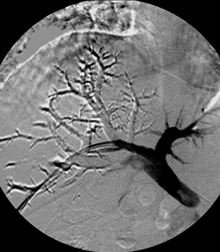What is Portal Vein Embolization?
The liver provides a variety of functions necessary for life. It is one of the only organs in the body that can grow new cells (regenerate) when stressed. It is also different in that it receives vital oxygen from both the hepatic artery and the portal vein. If a portion of the portal vein is blocked (embolized) the part of the liver receiving oxygen from it will die. The remainder of the liver, however will try to (regenerate).
Patients who have tumors of the liver can sometimes be cured with surgery. Unfortunately, for many people, the amount of liver that needs to be removed would leave them with such a small liver that it would not support life. In some of these patients we can artificially block the portion
of the portal vein that will be removed at surgery. This allows regeneration of the remainder of the liver during the next 4 – 6 weeks. During this time the liver can grow enough to support life after surgery.
How Successful is Portal Vein Embolization?
Portal vein embolization has a success rate of greater than 90%. Patients with cirrhosis, diabetes and bile duct obstruction have less success and may require longer waiting for the right amount of liver regeneration. Serious complications are less than 2% (2/100).
How Long Have We Been Performing Portal Vein Embolization?
We did our first portal vein embolization in 1994. Since then we have remained leaders in the field and the number of procedures we perform ranks in the top 5 worldwide.
How Does a Patient Prepare for Portal Vein Embolization?
The patients we see usually have some form of liver cancer and are referred to us (Interventional Radiology), by a liver surgeon hoping to get a cure. Most patients will already have had a CT scan and labs. The images, labs and history are reviewed at a consultation to determine if you are a candidate for the procedure. Please bring a list of your medications and possible allergies. If you are a candidate for the procedure you will show up in the morning of the exam and go to our holding area. You should refrain from eating from about midnight the night before the exam. If you take blood pressure medication, please take it as scheduled with a sip of water.
Are There Any Complications Associated With Portal Vein Embolization?
Portal Vein Embolization is a minimally invasive procedure and therefore is considered to be very safe. However, there are some associated risks, as there are with any medical procedure. Bleeding and unintentional embolization are the most common complications and occur less than 2 in 100 patients. Some patients experience nausea and vomiting as well as fever. These symptoms can be controlled with appropriate medications. A small number of patients may develop infection which can usually be controlled with antibiotics.
What Happens After The Procedure?
After the procedure, the catheter is removed from the liver and pressure is applied to the side to prevent any bleeding. After recovery in our holding area, the patient is transported to their hospital room where they will recover and be observed overnight. The patient must lie in bed for approximately 4 hours but will be able to eat and drink as tolerated. Most patients leave the day after the procedure. We will be in contact with you after discharge. A repeat CT scan is done in approximately 4 – 6 weeks to confirm regeneration and enlargement of the liver.

